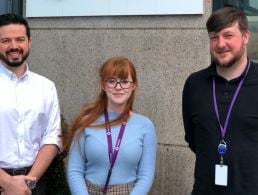If you’re ever wondering how to make a profit out of technology, look no further than Maurice Healy (pictured), CEO of Alternative Investment Market-listed voice and data technology firm Calyx, which has evolved from a hardware reselling business based on high volumes and tight margins to being a service-based IT player with recurring revenues. The company has made at least six acquisitions in the past two years and is planning at least two more in the near future.
From his office on Dublin’s Mount Street, Healy comes across as an individual with a crystal clear perception and understanding of the ebb and flow of technology spending in Ireland today. He knows what IT people are spending their money on and why.
This intuitive understanding of Ireland’s technology market was hardened by years building and acquiring technology companies. This understanding is tempered by running companies that have both listed and delisted on public markets as the occasion demands.
Healy and John Nagle started ITG back in 1989 and grew the voice and data side of the business before entering the credit-card transaction market during the Nineties. The company was the first Irish business to float on London’s AIM in 1997 as well as Dublin’s Developing Companies Market. ITG changed its name to Alphyra in 1999 and Healy and Nagle continued to grow both sides of the business. Then a number of factors shook things up.
In 2001 an unprecedented downturn impacted the IT and telecoms industries and businesses across the world instigated a capital expenditure freeze. Institutional investors pressured Alphyra to sell off its voice and data business in order to focus on the untainted credit-card business, Healy claims. The board put the voice and data business up for sale but after a year no bids were forthcoming and Healy decided to lead a management buyout (MBO). As a result, Calyx and Alphyra went their separate ways.
Healy recalls: “To be honest it was a highly geared MBO and I raised €12.8m to buy the business. Anglo Irish Bank put up €8.8m. We had to radically change the business. It was predominantly a hardware reseller business and at the time margins were falling.” To illustrate his point, Healy says turnover in 2002 fell from €36m down to €30m in 2003.
“In the first 12 months we concentrated on services, overheads and margins. We built up a strong team to do that and we started to generate cash and profits that paid off our debts. We repaid our loan to Anglo Irish Bank two years early,” says Healy, explaining the move in the direction of services helped bolster margins and last year the company turned over €34.5m.
In 2003, Calyx embarked on an acquisition trail, pursuing companies that were guaranteed to generate recurring revenues from services. The company has made at least six acquisitions in the past two years, including the €4.5m acquisition of Moss Technology and the €1m joint acquisition of Vipertec and Bevcom. In recent months the company acquired Convergent Systems for €600k in cash.
Healy affirms the company is still on the acquisition trail and plans to acquire two more companies in the Irish market this year, with plans to enter the UK market through acquisition in the first half of next year.
He says: “We are in talks with a number of companies and feel it is important we acquire at the right price.
“Depending on the size of the acquisition, we would use cash or shares. At the moment our shares are cheap relative to the multiples that are out there for companies in our sector and that is understandable because it’s our first share and they’ve got to see our numbers come through.”
Looking at Calyx as it stands today, currently employing 190 people, Healy believes the company’s policy of helping businesses reduce their IT costs and thereby free up more money to invest in IT is paying off. “There are two elements to the business going forward. One is the organic and the other is the acquisitive. We have a strong balance sheet now and we have the resources do to what we want. We are hoping to do a couple of acquisitions in Ireland this year and then our intention is to be in the UK in the first half of next year. We are looking at Calyx-like companies in the UK and are talking to people there. The intention is that we will use our resources, the network operating centre here and manage it from Dublin. This year and next year we are targeting Ireland and the UK.
“About 70pc of IT budgets today are spent maintaining existing systems so there isn’t a lot left over for developing and growing it. IT strategy has fallen out of line with business strategy. We can reduce their costs to 40pc of budget, thereby freeing up more to invest in bringing IT strategy in line with business strategy. A lot of businesses don’t have IT people and if they do they could be better employed by working on strategy and development of IT.”
Despite this, Healy believes the traditional disconnect between IT people and the board of their company is gradually being eradicated: “It is changing. CEOs and chief financial officers understand that a strategic investment in their IT strategy will deliver serious benefits, more efficiencies, lower costs and higher profits, higher margins.
“Companies that are not bringing an IT director into the strategic development of the business are going to lose out because it is going to be one of the main drivers of the development of any business. Awareness is increasing and the companies that don’t bring IT people into the strategic discussions will lose out in the longer term,” Healy concludes.
By John Kennedy




